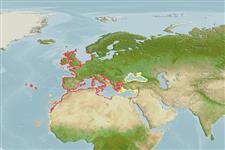Common names from other countries
Environment: milieu / climate zone / depth range / distribution range
Sinh thái học
Biển; Nước ngọt; Thuộc về nước lợ gần đáy; sống cả ở nước ngọt và nuớc mặn (Ref. 46888); Mức độ sâu 0 - 15 m (Ref. 45332). Subtropical; 8°C - 24°C (Ref. 4944); 60°N - 12°N, 32°W - 42°E
Eastern Atlantic: western Scotland to Senegal. Also known from the Mediterranean and Black Sea. Indian Ocean: as lessepsian migrant in the Gulf of Eilat and Red Sea (Ref. 5299). Records from Pointe Noire and vicinity might be doubtful.
Length at first maturity / Bộ gần gũi / Khối lượng (Trọng lượng) / Age
Maturity: Lm 6.5, range 6 - 7 cm
Max length : 13.0 cm TL con đực/không giới tính; (Ref. 49698); Tuổi cực đại được báo cáo: 10 các năm (Ref. 35388)
Neck naked. No black spots in the front end of each dorsal fin (Ref. 35388).
Predominantly marine, but may enter freshwater. Adults occur inshore in intertidal waters, under stones and in pools on sheltered rocky shores with much weed cover. Macrobenthos feeder on hard substrates (Ref. 92840), they feed on crustaceans (larger amphipods, isopods, small crabs) and polychaetes; juveniles eat harpacticoid copepods, amphipods, polychaetes and mites (Ref. 4696). Oviparous (Ref. 205). Fusiform shaped eggs are found in patches of several thousand on undersurface of stones, shells, polychaete tubes or Ciona mantles (Ref. 4696).
Oviparous (Ref. 205). Male guards the eggs deposited by the female under rocks or inside empty bivalve shells until they hatch (Ref. 45332). Larvae remain near the substrate until they assume the cryptobenthic behavior of the adults (Ref. 45332). Are repeat spawners (Ref. 4696).
Maugé, L.A., 1986. Gobiidae. p. 358-388. In J. Daget, J.-P. Gosse and D.F.E. Thys van den Audenaerde (eds.) Check-list of the freshwater fishes of Africa (CLOFFA). ISNB, Brussels; MRAC, Tervuren; and ORSTOM, Paris. Vol. 2. (Ref. 4343)
IUCN Red List Status (Ref. 130435)
CITES (Ref. 128078)
Not Evaluated
Threat to humans
Harmless
Human uses
Các nghề cá: buôn bán nhỏ; Bể nuôi cá: Bể cá công cộng
Các công cụ
Special reports
Download XML
Các nguồn internet
Estimates based on models
Preferred temperature (Ref.
115969): 9.8 - 20.2, mean 17.7 (based on 823 cells).
Phylogenetic diversity index (Ref.
82804): PD
50 = 0.5000 [Uniqueness, from 0.5 = low to 2.0 = high].
Bayesian length-weight: a=0.00871 (0.00672 - 0.01128), b=3.10 (3.06 - 3.14), in cm Total Length, based on LWR estimates for this species (Ref.
93245).
Mức dinh dưỡng (Ref.
69278): 3.3 ±0.45 se; based on food items.
Thích nghi nhanh (Ref.
120179): Trung bình, thời gian nhân đôi của chủng quần tối thiểu là 1.4 - 4.4 năm (K=0.41; tm=0-3; tmax=10; Fec=1,054).
Fishing Vulnerability (Ref.
59153): Low vulnerability (19 of 100).
